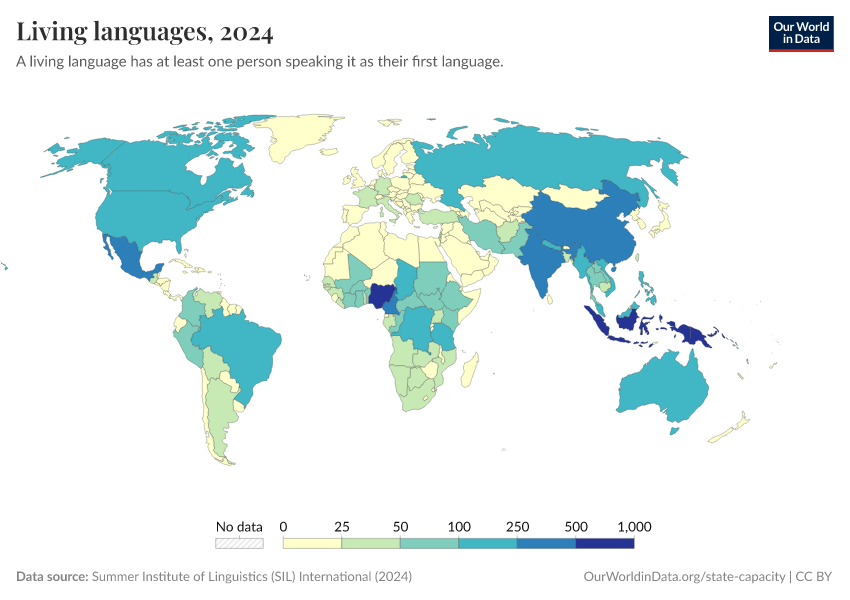Living languages

What you should know about this indicator
- A living language is one that is still in use, with at least one person using it as their first language.
- For a living language to be counted in each country, it must either be indigenous to that country or be non-indigenous and counted as established.
- To be considered established, a non-indigenous language must be both being acquired by the next generation, either in the home, or through mandatory schooling on in the work place. Additionally, its use must be the norm, either as a first or second language within a language community or community of practice, for example students who learn it as a second language in a school system.
- Living languages can be classified as either institutional, stable or endangered, based on how likely they are to be transmitted to future generations. Institutional languages are those most likely to be passed on, while endangered languages are at the highest risk of falling out of use.
What you should know about this indicator
- A living language is one that is still in use, with at least one person using it as their first language.
- For a living language to be counted in each country, it must either be indigenous to that country or be non-indigenous and counted as established.
- To be considered established, a non-indigenous language must be both being acquired by the next generation, either in the home, or through mandatory schooling on in the work place. Additionally, its use must be the norm, either as a first or second language within a language community or community of practice, for example students who learn it as a second language in a school system.
- Living languages can be classified as either institutional, stable or endangered, based on how likely they are to be transmitted to future generations. Institutional languages are those most likely to be passed on, while endangered languages are at the highest risk of falling out of use.
Sources and processing
This data is based on the following sources
How we process data at Our World in Data
All data and visualizations on Our World in Data rely on data sourced from one or several original data providers. Preparing this original data involves several processing steps. Depending on the data, this can include standardizing country names and world region definitions, converting units, calculating derived indicators such as per capita measures, as well as adding or adapting metadata such as the name or the description given to an indicator.
At the link below you can find a detailed description of the structure of our data pipeline, including links to all the code used to prepare data across Our World in Data.
Notes on our processing step for this indicator
Languages are aggregated to the continent level with each language being counted only once for each region it is spoken in.
Reuse this work
- All data produced by third-party providers and made available by Our World in Data are subject to the license terms from the original providers. Our work would not be possible without the data providers we rely on, so we ask you to always cite them appropriately (see below). This is crucial to allow data providers to continue doing their work, enhancing, maintaining and updating valuable data.
- All data, visualizations, and code produced by Our World in Data are completely open access under the Creative Commons BY license. You have the permission to use, distribute, and reproduce these in any medium, provided the source and authors are credited.
Citations
How to cite this page
To cite this page overall, including any descriptions, FAQs or explanations of the data authored by Our World in Data, please use the following citation:
“Data Page: Living languages”, part of the following publication: Bastian Herre and Pablo Arriagada (2023) - “State Capacity”. Data adapted from Summer Institute of Linguistics (SIL) International. Retrieved from https://archive.ourworldindata.org/20251023-195030/grapher/living-languages.html [online resource] (archived on October 23, 2025).How to cite this data
In-line citationIf you have limited space (e.g. in data visualizations), you can use this abbreviated in-line citation:
Summer Institute of Linguistics (SIL) International (2025) – with major processing by Our World in DataFull citation
Summer Institute of Linguistics (SIL) International (2025) – with major processing by Our World in Data. “Living languages” [dataset]. Summer Institute of Linguistics (SIL) International, “Ethnologue” [original data]. Retrieved November 4, 2025 from https://archive.ourworldindata.org/20251023-195030/grapher/living-languages.html (archived on October 23, 2025).